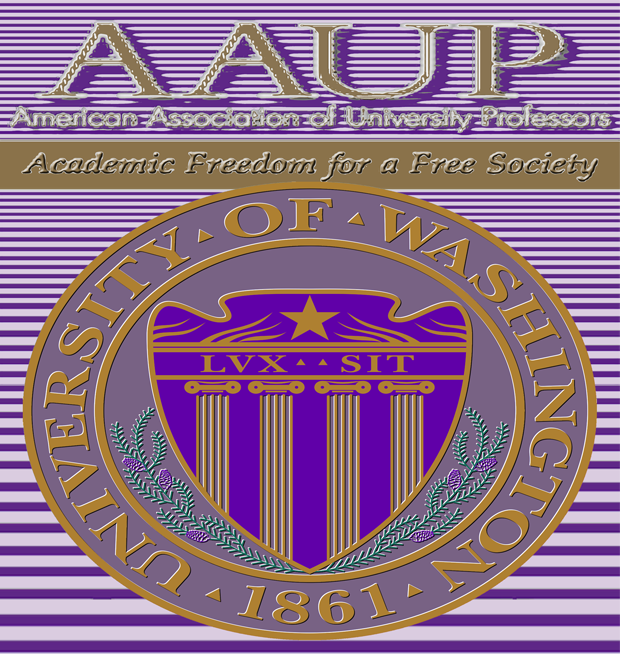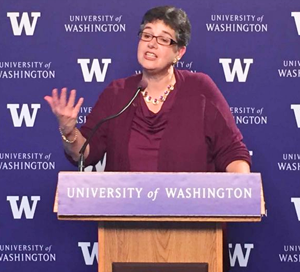
 Response to AAUP comment about the appointment of a UW Provost with no search
Response to AAUP comment about the appointment of a UW Provost with no search
Before appointing a search committee, I asked for advice as to whether to proceed with such a search at the Senate Executive Committee (Professor Wood was present at that meeting). I further asked that if anyone had concerns/objections they should forward them to the Faculty Senate Chair. No objections were received. It was only then that I moved forward with putting together a committee for futher consultation, all with full involvement of elected leadership of Faculty Senate, GPSS, and ASUW. There was NEVER any secrecy and I find it very odd to be hearing the FIRST objections EVER at this late stage.
Jerry Baldasty would have retired this year (maybe even last) had I not asked him to step into the interim role; this is certainly NOT about his ambition. And, my plan to move in this direction was, in fact, motivated by my desire to be transparent and honest. The choice of a Provost is ultimately mine to – albeit after consultation. It would be easy enough to go through a search having a “preferred” candidate, while giving the appearance of total openness. But, that’s not who I am and I don’t think that’s fair to other potential candidates or to you.
My rationale for moving in this direction is simple. Jerry and I are in the process of making some, potentially pretty extensive, changes to administrative structures so that we can do precisely what the faculty (and AAUP) have been calling for – streamlining administration so that our various academic support (aka administrative) units can run more efficiently, and free up resources to serve the academic mission. We are calling this “Transforming Administration.” An example of this is the work Jerry oversaw which is transforming a building that was used for parking services into a daycare center – the first such center to open up in over a decade.
We are still in the early stages of the initiative and I believe (and the broad group I consulted with agreed) that continuity in leadership was important at this time. In considering an “up to three year” appointment, you should take into account that a full national search – which I think we should conduct for the next provost – would mean that we would be spending all next year searching and interviewing. A new Provost would not arrive until the academic year beginning Fall 2017. So, Jerry would be serving as Provost next year anyways.
At present, the plan would be to launch the national search in Fall of 2017, with a new Provost arriving in Fall of 2018 –meaning that Jerry (if approved) would serve in this office for one additional year than would be the case anyways. We’ve said “up to three” to leave wiggle room in the case the search fails or some other unforeseen situation emerges.
Moreover, I will not be making the decision until receiving input from faculty, staff, and students following a formal talk and presentation.
One think I’ve been struck by, and I’ve said this in various venues, is that all the changes and “churn” in the President and Provost’s office (we’ve had 4 people – Emmert, Wise, Young now me – in the President’s office in the last 6 years; and even more provosts – Wise, Lidstrom, Wadden, Cauce, now Baldasty, and even more different combinations of the two. The changes have been every greater if you take into account that various of us served in interim positions – Wise, Lidstrom, Wadden, me, Baldasty – for some time). This has resulted in a lack of attention and focus to our administrative structures, practices and processes. Our administrative units have become more de-centralized during this time and we have not paid enough attention to how they work in concert with each other, and in service to, our academic mission. This is exactly the work that Jerry and I, with the help of many, and with clear involvement of elected faculty leadership, are taking on.
Jerry has not only been a long-standing member of our community (he was an undergrad here) but is very knowledgeable about its workings, having served as both Dean and Vice Provost of the Graduate School and Senior Vice Provost, positions that work across the campus. He is ready, willing, and able to take on some very difficult challenges that would simply not be possible for someone new to take on. It is important to keep in mind that when the office of the Provost is weak, the more the university is run by non-academics. We have truly fabulous, dedicated non-faculty university leaders, this is not about the individuals we have in leadership positions. But, I believe there is some work to be done to (re?)-establish a culture where service to the academic mission is at the core of all we do. This can best be done with continuity in the President/Provost’s office at this moment in time. That is what this proposal was all about. And, so far, elected leadership has agreed, so has a broad based search advisory committee.
This is a very difficult time for academic leadership. Great universities like UBC, Berkeley, Illinois (to name just a few of the more obvious ones) have seen a number of very quick transitions in the President and/or Provost’s offices. In our own PNW, the Council of Presidents (Presidents of the 4 year universities) will see changes in all but one president in just the last three years, it’s not that different amongst Presidents of the PAC-12. While there are opportunities with new leadership, it can also be de-stabilizing as (preferably trusting) working relationships are important to the work that needs to be done.
So, please – Do attend Jerry’s talk, or stream in, then make up your own mind what’s in the best interest of the university. There will opportunity for feedback after the fact. I will be taking that feedback very seriously. I can assure you that Jerry has no interest in the job if there is not good support for his candidacy. And, it will not serve the purposes I describe to keep him in this position unless he has strong support; without it, we can’t accomplish what is needed.
Ana Mari